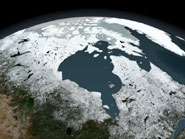Younger, hotter Earth still not understood

Plate tectonics may not have operated on a younger and hotter Earth according to new research from the University of Bristol carried out on preserved remnants of ancient continental crust in the Hudson Bay region of Canada.
The processes that formed and shaped the early Earth’s crust are still poorly understood, and the onset of plate tectonics has been estimated as being as early as the Hadean (4.6-3.8 billion years ago) or as late as the Neoproterozoic (1,000-542 million years ago).
The Hudson Bay region represents an excellent opportunity to investigate crustal formation during the Precambrian (that is from the formation of the Earth, almost 4.6 billion years ago, until 542 million years ago). It records tectonic events leading to the formation and stabilisation of the Laurentian continent (most of modern-day North America) and also preserves crust with ages spanning around 2 billion years.
David Thompson, a PhD student in Bristol’s Department of Earth Sciences, and colleagues from the University of Calgary and the Geological Survey of Canada analysed the structure and thickness of the crust using seismic waves to investigate what tectonic process were operating on the younger Earth.
They found that the crust between 3.9 and 2.7 billion years old had a relatively simple structure with no clear signs that it was subjected to the kind of plate tectonic processes operating now. The crust that formed about 1.8 billion years, however, showed evidence of the collision of two continents, similar to the collision between India and Asia still ongoing today.
The researchers then compared the observed structure of the Hudson Bay crust with continental crust of a similar age found elsewhere in the world. They concluded that modern-style plate tectonics may not have been established until as late as 1.8 billion years ago.
The research is published in Earth and Planetary Science Letters and was named as one of the Nature Geoscience's research highlights in their September issue.
More information: Precambrian crustal evolution: Seismic constraints from the Canadian Shield by D.A. Thompson, I.D. Bastow, G. Helffrich, J-M. Kendall, J. Wookey, D.B. Snyder, D.W. Eaton Earth and Planetary Science Letters 297 (2010) 655-666. www.sciencedirect.com/science/journal/0012821X
Provided by University of Bristol














